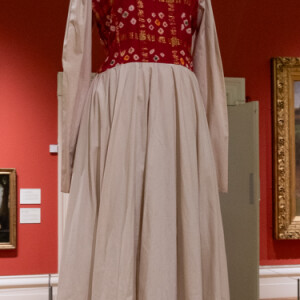Racist poster from the 1970s
Notwithstanding the brilliant Autumn sunshine, today promised a face to face meeting of the East Midlands group of the Royal Photographic Society in at the museum and art gallery in Leicester. I drove there, the farthest I've driven myself since January. A ten minute hiccup while I struggled to find the car park but thankfully, there was a disabled parking space.
The regional organiser was not there to greet me, having been injured in home manoeuvres, but I only learned that afterwards when he wrote to ask me to send words and pictures of the meeting we'd gone to visit. Sadly, I didn't recognise any other RPS members, although one or two were carrying cameras. It was a well attended open meeting to celebrate an exhibition of new photography by Kavi Pujara. Born in the Belgrave Road area of Leicester in 1972, he had left when he was 18 returning 30 years later with his young family.
His first photo was of Nora, an elderly white lady popularly known at the time as 'The Lollipop Lady.' She used to give him sanctuary when youths allied to The National Front use to go 'Paki-bashing' outside local schools. When she wasn't at home, he had to run the gauntlet.
Kavi had settled on this project to photograph The Golden Mile in Leicester as homage to the neighbourhood in which he'd grown up. Many associate this stretch of road extending from Belgrave Road to Melton Road as being a version of Indian commerce with jewellery shops, restaurants and Indian sweet outlets, sari and Punjabi suit shops. Another explanation is that the name came from the amber lights of the traffic lights that were installed as Asian immigrants moved in, notably from East Africa. Kavi's own parents had come from Kenya and Uganda. Aside from the National Front, attitudes in Britain in the 1970s were decidedly racist. The British government and the city authorities attempted to influence immigrants NOT to settle in Leicester.
Kavi's project intended to investigate the impact of Brexit and more on his community notably during the Covid lockdowns. Leicester had had an additional lockdown imposed in summer 2020. At first, he thought to use a small digital camera to record his work but this proved unsatisfactory. He finally chose to use a medium format camera that had to be mounted on a tripod. The advantages were twofold. One, people would approach him to ask what he was doing and were invariably sufficiently impressed to take part in his project. Two, using a tripod and medium format camera made him slow down and take care in what he included in the frame. In this way, he was able to establish his own relationships within the community by talking to the people that he met, otherwise difficult during the Covid lockdowns.
His photographs use bright coloured backgrounds. He is drawn to bright colours. His subjects at his request, pose as in static studio portraits and do not smile. Somehow, this gives the photos more impact. Because of lockdown rules, he was often not able to enter houses, so he would ask his subjects to bring out an object from their houses that meant a lot to them. Thus there are photos of a pair of well polished black boots and of a sewing machine out in the street.
Kavi was one of four recipients of a Martin Parr Foundation bursary in 2020 which he used to develop his project and had his work exhibited at the Martin Parr gallery late in 2022. He wrote, 'We have a multicultural society because Britain is the product of a multicultural empire. Communities like this are not an erosion of British values or its culture, but a vital artery in our intertwined and tangled colonial histories.'
Ironically, he has found that the inhabitants of The Golden Mile do not approve the influx of later immigrants of Asian descent.
The exhibition is not that large and is supported by a book that was crowd-funded. The photos are of excellent quality.
At the end, an art gallery representative asked us to take a little time to view the Kathak dress on display in the main gallery. It had been made in Leicester for a group of girls who were training in Kathak dance in 1996.


Comments
Sign in or get an account to comment.


